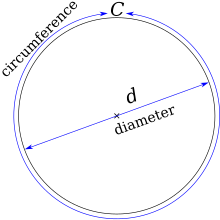Pi
| Part of a series of articles on the |
| mathematical constant π |
|---|
 |
| Uses |
| Properties |
| Value |
| People |
| History |
| In culture |
| Related topics |
Being an irrational number, π cannot be expressed exactly as a fraction (equivalently, its decimal representation never ends and never settles into a permanent repeating pattern). Still, fractions such as 22/7 and other rational numbers are commonly used to approximate π. The digits appear to be randomly distributed. In particular, the digit sequence of π is conjectured to satisfy a specific kind of statistical randomness, but to date no proof of this has been discovered. Also, π is a transcendental number; that is, a number that is not the root of any non-zero polynomial having rational coefficients. This transcendence of π implies that it is impossible to solve the ancient challenge of squaring the circle with a compass and straightedge.
Ancient civilizations required fairly accurate computed values for π for practical reasons. It was calculated to seven digits, using geometrical techniques, in Chinese mathematics, and to about five digits in Indian mathematics in the 5th century AD. The historically first exact formula for π, based on infinite series, was not available until a millennium later, when in the 14th century the Madhava–Leibniz series was discovered in Indian mathematics.[1][2] In the 20th and 21st centuries, mathematicians and computer scientists discovered new approaches that, when combined with increasing computational power, extended the decimal representation of π to many trillions of digits after the decimal point.[3] Practically all scientific applications require no more than a few hundred digits of π, and many substantially fewer, so the primary motivation for these computations is the quest to find more efficient algorithms for calculating lengthy numeric series, as well as the desire to break records.[4][5] The extensive calculations involved have also been used to test supercomputers and high-precision multiplication algorithms.
Because its most elementary definition relates to the circle, π is found in many formulae in trigonometry and geometry, especially those concerning circles, ellipses, and spheres. In more modern mathematical analysis, the number is instead defined using the spectral properties of the real number system, as an eigenvalue or a period, without any reference to geometry. It appears therefore in areas of mathematics and the sciences having little to do with the geometry of circles, such as number theory and statistics, as well as in almost all areas of physics. The ubiquity of π makes it one of the most widely known mathematical constants both inside and outside the scientific community; several books devoted to it have been published, the number is celebrated on Pi Day, and record-setting calculations of the digits of π often result in news headlines. Attempts to memorize the value of π with increasing precision have led to records of over 70,000 digits.
Contents
[hide]- 1 Fundamentals
- 2 History
- 3 Modern quest for more digits
- 4 Role and characterizations in mathematics
- 4.1 Geometry and trigonometry
- 4.2 Eigenvalues
- 4.3 Inequalities
- 4.4 Fourier transform and Heisenberg uncertainty principle
- 4.5 Gaussian integrals
- 4.6 Projective geometry
- 4.7 Topology
- 4.8 Vector calculus
- 4.9 Cauchy's integral formula
- 4.10 The gamma function and Stirling's approximation
- 4.11 Number theory and Riemann zeta function
- 4.12 Fourier series
- 4.13 Modular forms and theta functions
- 4.14 Cauchy distribution and potential theory
- 4.15 Complex dynamics
- 5 Outside mathematics
- 6 Notes
- 7 Further reading
- 8 External links
Fundamentals
Name
The symbol used by mathematicians to represent the ratio of a circle's circumference to its diameter is the lowercase Greek letter π, sometimes spelled out as pi, and derived from the first letter of the Greek word perimetros, meaning circumference.[6] In English, π is pronounced as "pie" (/paɪ/, paɪ).[7] In mathematical use, the lowercase letter π (or π in sans-serif font) is distinguished from its capitalized and enlarged counterpart ∏, which denotes a product of a sequence, analogous to how ∑ denotes summation.The choice of the symbol π is discussed in the section Adoption of the symbol π.
Definition
Here, the circumference of a circle is the arc length around the perimeter of the circle, a quantity which can be formally defined independently of geometry using limits, a concept in calculus.[9] For example, one may compute directly the arc length of the top half of the unit circle given in Cartesian coordinates by x2 + y2 = 1, as the integral:[10]
Definitions of π such as these that rely on a notion of circumference, and hence implicitly on concepts of the integral calculus, are no longer common in the literature. Remmert (1991) explains that this is because in many modern treatments of calculus, differential calculus typically precedes integral calculus in the university curriculum, so it is desirable to have a definition of π that does not rely on the latter. One such definition, due to Richard Baltzer,[12] and popularized by Edmund Landau,[13] is the following: π is twice the smallest positive number at which the cosine function equals 0.[8][10][14] The cosine can be defined independently of geometry as a power series,[15] or as the solution of a differential equation.[14]
In a similar spirit, π can be defined instead using properties of the complex exponential, exp(z), of a complex variable z. Like the cosine, the complex exponential can be defined in one of several ways. The set of complex numbers at which exp(z) is equal to one is then an (imaginary) arithmetic progression of the form:
A circle encloses the largest area that can be attained within a given perimeter. Thus the number π is also characterized as the best constant in the isoperimetric inequality (times one-fourth). There are many other, closely related, ways in which π appears as an eigenvalue of some geometrical or physical process; see below.




No comments:
Post a Comment